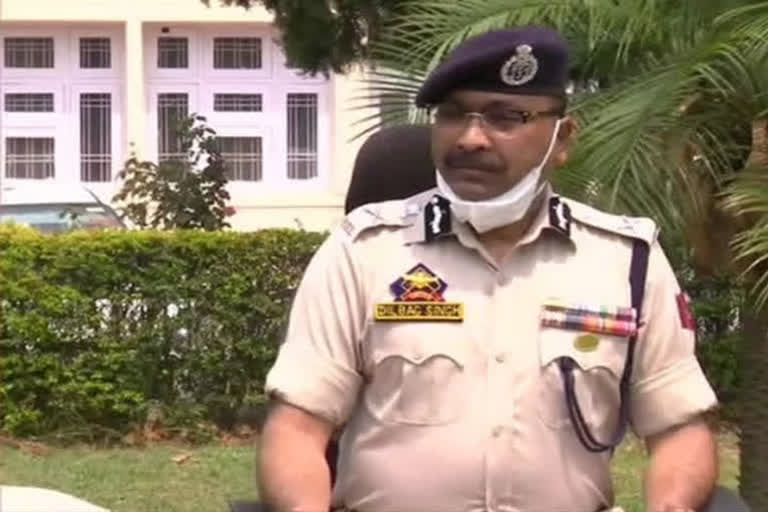Srinagar: Drones have added a new dimension to security threats from terror groups and investigations into the attack on the Jammu IAF station last month, show involvement of non-state actors, supported by state actors such as the ordnance factory of Pakistan, Jammu and Kashmir DGP Dilbag Singh said on Tuesday. He also pointed out that in the past, drones from across the border have been used to drop currency, arms and ammunition inside Indian territory and with the introduction of unmanned aerial vehicles (UAVs) in terror activities, more efforts are required to see to it that this new and emerging threat is neutralised effectively.
Singh, a 1987-batch IPS officer, spoke on various issues during an interview with the agencies media, and these included the present situation on the militancy front and the new threats that have emerged with the use of drones by terror outfits like the banned Lashkar-e-Taiba (LeT). "Drones have come recently, say in September last year. First, that came as a big surprise, but we were able to gear up our resources to counter that threat. I am happy to report that in cases of use of drones carrying weapons and narcotics and other explosives... our security grid, intelligence grid of police and security agencies, was very effective in taking countermeasures,” the DGP said. "We were able to intercept around 32 sorties out of roughly 40 sorties which were made," Singh said.
However, what happened during the intervening night of June 26 and 27 at the Jammu Indian Air Force (IAF) station, where drones were used to drop improvised explosive devices (IEDs), was "a very condemnable incident and very wrong kind of doing on the part of non-state actors (terror groups) who are likely to have been supported by state actors (Pakistan army or ISI)", he said. "Picking up this kind of a target has added a new dimension to our security threats from terrorists. We have taken countermeasures. Certain additional technologies have been deployed along the border. We are trying to take extra precaution with regard to vital installations," Singh said.
Also Read: Pak looking for soft targets to foment trouble in J&K: DGP
When asked to give details of investigations into the drone attack on the IAF station in Jammu, he said the probe suggests a couple of things like the flight path of the drones suggests they came from Pakistan right to the airfield, and the aerial distance from the IAF station to the international border is 14 km. The second and most important part that emerged during the investigation, was that expert opinion "suggested that the IEDs may have been fabricated by a well-organised unit like an ordnance unit...it suggested certain footprints of an ordnance unit so that kind of assessment was there", Singh said.
The other aspect was that the explosive material which was used in the IEDs was RDX and this is not available in the open market. It is a military-grade explosive material and it definitely must have been sourced from a government agency from across the border, he said. IEDs, weighing around six to seven kgs, which were seized on the same day of the IAF base attack, from another part of Jammu had also been dropped from a drone and collected by a terrorist who was subsequently arrested, the DGP said.
The LeT terror group has been on a regular basis using drones for dropping weapons, drugs and money, he said. "This act (attack on Jammu IAF station) also seems to have certain signatures of the LeT... certain indications like the kind of explosives used and nature of the explosive and nature of fabrication, definitely suggested that apart from non-state actors, state actors also must have been involved in the process," Singh said. He said drones in the recent past have not only been used to drop arms and ammunition, but also has been used to send money to maintain the terror network in Jammu and Kashmir.
Also Read: NSG radar picked up drone around Jammu air base: Intelligence sources
"The money dropped from drones was in Indian currency. Amount was not very huge. It was only Rs 50,000 but even this amount for a particular person to do a particular job is good enough for one terror attack," he said without sharing further details. Singh said cash has come in other forms too. "Some people had visited Pakistan and returned with tiffin carriers as a gift item. Around the tiffin box's metal and plastic part, within the cavity, where currency notes from Pakistan. So, a tiffin box could easily carry Rs 1 lakh to Rs 2 lakh rupees to be given to particular OGWs (over ground workers) working in areas of Jammu and Doda," he said.
"We were able to capture a large number of such items which came from Pakistan through people who visited those places. Other than that, during one of our searches we were able to catch, I think, Rs 26 lakh of cash from a truck which was coming from Samba to Kashmir. That money also was basically realised from narcotics from Punjab," Singh said. Earlier in Handwara, more than Rs 1 crore and Rs 20-25 lakhs was seized by police from a narcotics smuggler who was distributing cash among OGWs and active terrorists and their families, the DGP said, adding so these incidents have come to our notice and serious action has been taken on that count. "But drones, we definitely need to put in more effort to see that this emerging threat is neutralised effectively," he added.
Also Read: India probes 'drone strike' on Jammu airport
PTI



